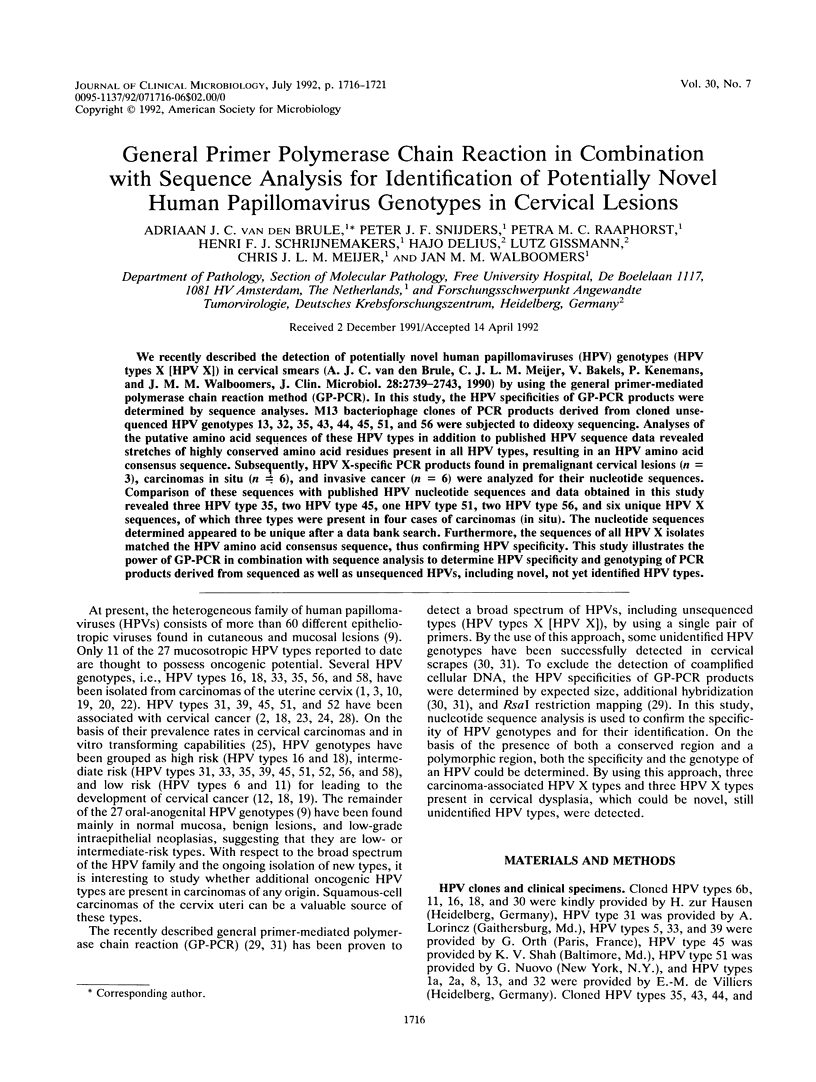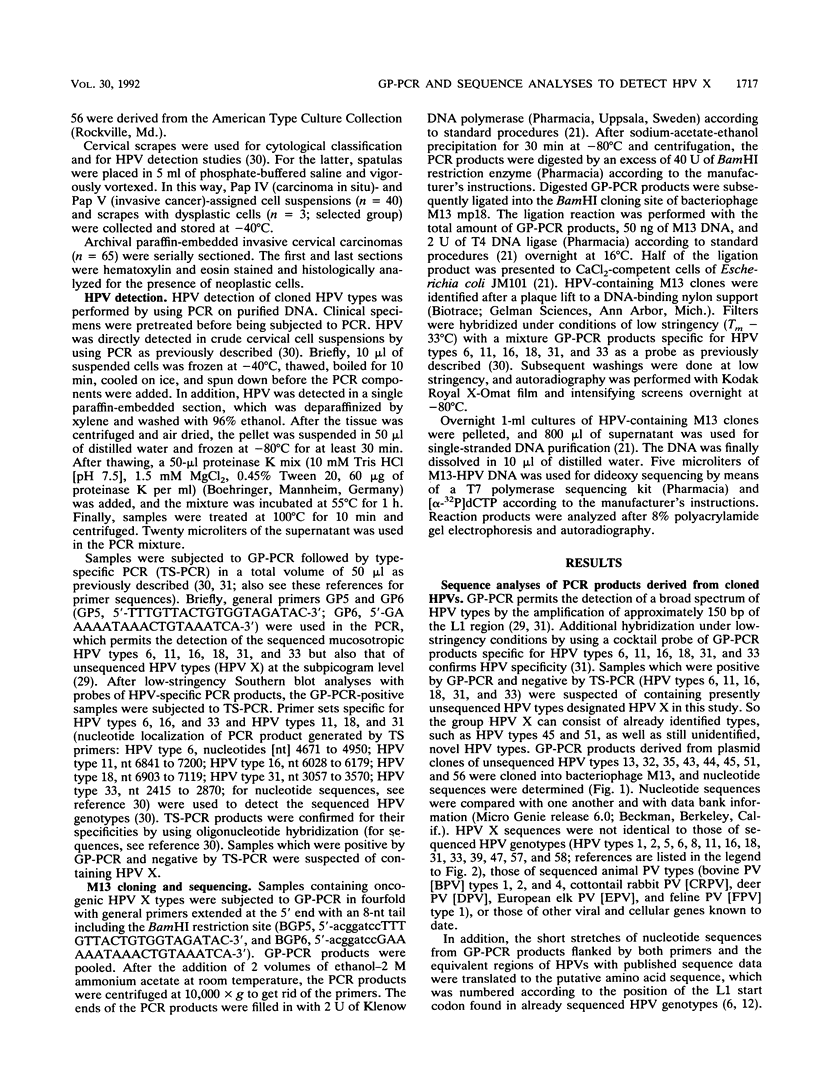Abstract
We recently described the detection of potentially novel human papillomaviruses (HPV) genotypes (HPV types X [HPV X]) in cervical smears (A. J. C. van den Brule, C. J. L. M. Meijer, V. Bakels, P. Kenemans, and J. M. M. Walboomers, J. Clin. Microbiol. 28:2739-2743, 1990) by using the general primer-mediated polymerase chain reaction method (GP-PCR). In this study, the HPV specificities of GP-PCR products were determined by sequence analyses. M13 bacteriophage clones of PCR products derived from cloned unsequenced HPV genotypes 13, 32, 35, 43, 44, 45, 51, and 56 were subjected to dideoxy sequencing. Analyses of the putative amino acid sequences of these HPV types in addition to published HPV sequence data revealed stretches of highly conserved amino acid residues present in all HPV types, resulting in an HPV amino acid consensus sequence. Subsequently, HPV X-specific PCR products found in premalignant cervical lesions (n = 3), carcinomas in situ (n = 6), and invasive cancer (n = 6) were analyzed for their nucleotide sequences. Comparison of these sequences with published HPV nucleotide sequences and data obtained in this study revealed three HPV type 35, two HPV type 45, one HPV type 51, two HPV type 56, and six unique HPV X sequences, of which three types were present in four cases of carcinomas (in situ). The nucleotide sequences determined appeared to be unique after a data bank search. Furthermore, the sequences of all HPV X isolates matched the HPV amino acid consensus sequence, thus confirming HPV specificity. This study illustrates the power of GP-PCR in combination with sequence analysis to determine HPV specificity and genotyping of PCR products derived from sequenced as well as unsequenced HPVs, including novel, not yet identified HPV types.
Full text
PDF





Selected References
These references are in PubMed. This may not be the complete list of references from this article.
- Beaudenon S., Kremsdorf D., Croissant O., Jablonska S., Wain-Hobson S., Orth G. A novel type of human papillomavirus associated with genital neoplasias. Nature. 1986 May 15;321(6067):246–249. doi: 10.1038/321246a0. [DOI] [PubMed] [Google Scholar]
- Beaudenon S., Kremsdorf D., Obalek S., Jablonska S., Pehau-Arnaudet G., Croissant O., Orth G. Plurality of genital human papillomaviruses: characterization of two new types with distinct biological properties. Virology. 1987 Dec;161(2):374–384. doi: 10.1016/0042-6822(87)90130-9. [DOI] [PubMed] [Google Scholar]
- Boshart M., Gissmann L., Ikenberg H., Kleinheinz A., Scheurlen W., zur Hausen H. A new type of papillomavirus DNA, its presence in genital cancer biopsies and in cell lines derived from cervical cancer. EMBO J. 1984 May;3(5):1151–1157. doi: 10.1002/j.1460-2075.1984.tb01944.x. [DOI] [PMC free article] [PubMed] [Google Scholar]
- Cole S. T., Danos O. Nucleotide sequence and comparative analysis of the human papillomavirus type 18 genome. Phylogeny of papillomaviruses and repeated structure of the E6 and E7 gene products. J Mol Biol. 1987 Feb 20;193(4):599–608. doi: 10.1016/0022-2836(87)90343-3. [DOI] [PubMed] [Google Scholar]
- Cole S. T., Streeck R. E. Genome organization and nucleotide sequence of human papillomavirus type 33, which is associated with cervical cancer. J Virol. 1986 Jun;58(3):991–995. doi: 10.1128/jvi.58.3.991-995.1986. [DOI] [PMC free article] [PubMed] [Google Scholar]
- Danos O., Giri I., Thierry F., Yaniv M. Papillomavirus genomes: sequences and consequences. J Invest Dermatol. 1984 Jul;83(1 Suppl):7s–11s. doi: 10.1111/1523-1747.ep12281115. [DOI] [PubMed] [Google Scholar]
- Danos O., Katinka M., Yaniv M. Human papillomavirus 1a complete DNA sequence: a novel type of genome organization among papovaviridae. EMBO J. 1982;1(2):231–236. doi: 10.1002/j.1460-2075.1982.tb01152.x. [DOI] [PMC free article] [PubMed] [Google Scholar]
- Dartmann K., Schwarz E., Gissmann L., zur Hausen H. The nucleotide sequence and genome organization of human papilloma virus type 11. Virology. 1986 May;151(1):124–130. doi: 10.1016/0042-6822(86)90110-8. [DOI] [PubMed] [Google Scholar]
- Dürst M., Gissmann L., Ikenberg H., zur Hausen H. A papillomavirus DNA from a cervical carcinoma and its prevalence in cancer biopsy samples from different geographic regions. Proc Natl Acad Sci U S A. 1983 Jun;80(12):3812–3815. doi: 10.1073/pnas.80.12.3812. [DOI] [PMC free article] [PubMed] [Google Scholar]
- Fuchs P. G., Iftner T., Weninger J., Pfister H. Epidermodysplasia verruciformis-associated human papillomavirus 8: genomic sequence and comparative analysis. J Virol. 1986 May;58(2):626–634. doi: 10.1128/jvi.58.2.626-634.1986. [DOI] [PMC free article] [PubMed] [Google Scholar]
- Goldsborough M. D., DiSilvestre D., Temple G. F., Lorincz A. T. Nucleotide sequence of human papillomavirus type 31: a cervical neoplasia-associated virus. Virology. 1989 Jul;171(1):306–311. doi: 10.1016/0042-6822(89)90545-x. [DOI] [PubMed] [Google Scholar]
- Hirsch-Behnam A., Delius H., de Villiers E. M. A comparative sequence analysis of two human papillomavirus (HPV) types 2a and 57. Virus Res. 1990 Dec;18(1):81–97. doi: 10.1016/0168-1702(90)90091-o. [DOI] [PubMed] [Google Scholar]
- Ho L., Chan S. Y., Chow V., Chong T., Tay S. K., Villa L. L., Bernard H. U. Sequence variants of human papillomavirus type 16 in clinical samples permit verification and extension of epidemiological studies and construction of a phylogenetic tree. J Clin Microbiol. 1991 Sep;29(9):1765–1772. doi: 10.1128/jcm.29.9.1765-1772.1991. [DOI] [PMC free article] [PubMed] [Google Scholar]
- Keohavong P., Thilly W. G. Fidelity of DNA polymerases in DNA amplification. Proc Natl Acad Sci U S A. 1989 Dec;86(23):9253–9257. doi: 10.1073/pnas.86.23.9253. [DOI] [PMC free article] [PubMed] [Google Scholar]
- Kirii Y., Iwamoto S., Matsukura T. Human papillomavirus type 58 DNA sequence. Virology. 1991 Nov;185(1):424–427. doi: 10.1016/0042-6822(91)90791-9. [DOI] [PubMed] [Google Scholar]
- Kiyono T., Adachi A., Ishibashi M. Genome organization and taxonomic position of human papillomavirus type 47 inferred from its DNA sequence. Virology. 1990 Jul;177(1):401–405. doi: 10.1016/0042-6822(90)90500-q. [DOI] [PubMed] [Google Scholar]
- Lorincz A. T., Lancaster W. D., Temple G. F. Cloning and characterization of the DNA of a new human papillomavirus from a woman with dysplasia of the uterine cervix. J Virol. 1986 Apr;58(1):225–229. doi: 10.1128/jvi.58.1.225-229.1986. [DOI] [PMC free article] [PubMed] [Google Scholar]
- Lorincz A. T., Quinn A. P., Lancaster W. D., Temple G. F. A new type of papillomavirus associated with cancer of the uterine cervix. Virology. 1987 Jul;159(1):187–190. doi: 10.1016/0042-6822(87)90366-7. [DOI] [PubMed] [Google Scholar]
- Lörincz A. T., Quinn A. P., Goldsborough M. D., McAllister P., Temple G. F. Human papillomavirus type 56: a new virus detected in cervical cancers. J Gen Virol. 1989 Nov;70(Pt 11):3099–3104. doi: 10.1099/0022-1317-70-11-3099. [DOI] [PubMed] [Google Scholar]
- Matsukura T., Sugase M. Molecular cloning of a novel human papillomarvirus (type 58) from an invasive cervical carcinoma. Virology. 1990 Aug;177(2):833–836. doi: 10.1016/0042-6822(90)90560-e. [DOI] [PubMed] [Google Scholar]
- Naghashfar Z. S., Rosenshein N. B., Lorincz A. T., Buscema J., Shah K. V. Characterization of human papillomavirus type 45, a new type 18-related virus of the genital tract. J Gen Virol. 1987 Dec;68(Pt 12):3073–3079. doi: 10.1099/0022-1317-68-12-3073. [DOI] [PubMed] [Google Scholar]
- Reuter S., Delius H., Kahn T., Hofmann B., zur Hausen H., Schwarz E. Characterization of a novel human papillomavirus DNA in the cervical carcinoma cell line ME180. J Virol. 1991 Oct;65(10):5564–5568. doi: 10.1128/jvi.65.10.5564-5568.1991. [DOI] [PMC free article] [PubMed] [Google Scholar]
- Schlegel R., Phelps W. C., Zhang Y. L., Barbosa M. Quantitative keratinocyte assay detects two biological activities of human papillomavirus DNA and identifies viral types associated with cervical carcinoma. EMBO J. 1988 Oct;7(10):3181–3187. doi: 10.1002/j.1460-2075.1988.tb03185.x. [DOI] [PMC free article] [PubMed] [Google Scholar]
- Schwarz E., Dürst M., Demankowski C., Lattermann O., Zech R., Wolfsperger E., Suhai S., zur Hausen H. DNA sequence and genome organization of genital human papillomavirus type 6b. EMBO J. 1983;2(12):2341–2348. doi: 10.1002/j.1460-2075.1983.tb01744.x. [DOI] [PMC free article] [PubMed] [Google Scholar]
- Seedorf K., Krämmer G., Dürst M., Suhai S., Röwekamp W. G. Human papillomavirus type 16 DNA sequence. Virology. 1985 Aug;145(1):181–185. doi: 10.1016/0042-6822(85)90214-4. [DOI] [PubMed] [Google Scholar]
- Shimoda K., Lorincz A. T., Temple G. F., Lancaster W. D. Human papillomavirus type 52: a new virus associated with cervical neoplasia. J Gen Virol. 1988 Nov;69(Pt 11):2925–2928. doi: 10.1099/0022-1317-69-11-2925. [DOI] [PubMed] [Google Scholar]
- Snijders P. J., van den Brule A. J., Schrijnemakers H. F., Snow G., Meijer C. J., Walboomers J. M. The use of general primers in the polymerase chain reaction permits the detection of a broad spectrum of human papillomavirus genotypes. J Gen Virol. 1990 Jan;71(Pt 1):173–181. doi: 10.1099/0022-1317-71-1-173. [DOI] [PubMed] [Google Scholar]
- Van Den Brule A. J., Walboomers J. M., Du Maine M., Kenemans P., Meijer C. J. Difference in prevalence of human papillomavirus genotypes in cytomorphologically normal cervical smears is associated with a history of cervical intraepithelial neoplasia. Int J Cancer. 1991 May 30;48(3):404–408. doi: 10.1002/ijc.2910480317. [DOI] [PubMed] [Google Scholar]
- Volpers C., Streeck R. E. Genome organization and nucleotide sequence of human papillomavirus type 39. Virology. 1991 Mar;181(1):419–423. doi: 10.1016/0042-6822(91)90518-g. [DOI] [PubMed] [Google Scholar]
- Zachow K. R., Ostrow R. S., Faras A. J. Nucleotide sequence and genome organization of human papillomavirus type 5. Virology. 1987 May;158(1):251–254. doi: 10.1016/0042-6822(87)90263-7. [DOI] [PubMed] [Google Scholar]
- de Villiers E. M. Heterogeneity of the human papillomavirus group. J Virol. 1989 Nov;63(11):4898–4903. doi: 10.1128/jvi.63.11.4898-4903.1989. [DOI] [PMC free article] [PubMed] [Google Scholar]
- van den Brule A. J., Meijer C. J., Bakels V., Kenemans P., Walboomers J. M. Rapid detection of human papillomavirus in cervical scrapes by combined general primer-mediated and type-specific polymerase chain reaction. J Clin Microbiol. 1990 Dec;28(12):2739–2743. doi: 10.1128/jcm.28.12.2739-2743.1990. [DOI] [PMC free article] [PubMed] [Google Scholar]
- van den Brule A. J., Snijders P. J., Gordijn R. L., Bleker O. P., Meijer C. J., Walboomers J. M. General primer-mediated polymerase chain reaction permits the detection of sequenced and still unsequenced human papillomavirus genotypes in cervical scrapes and carcinomas. Int J Cancer. 1990 Apr 15;45(4):644–649. doi: 10.1002/ijc.2910450412. [DOI] [PubMed] [Google Scholar]


